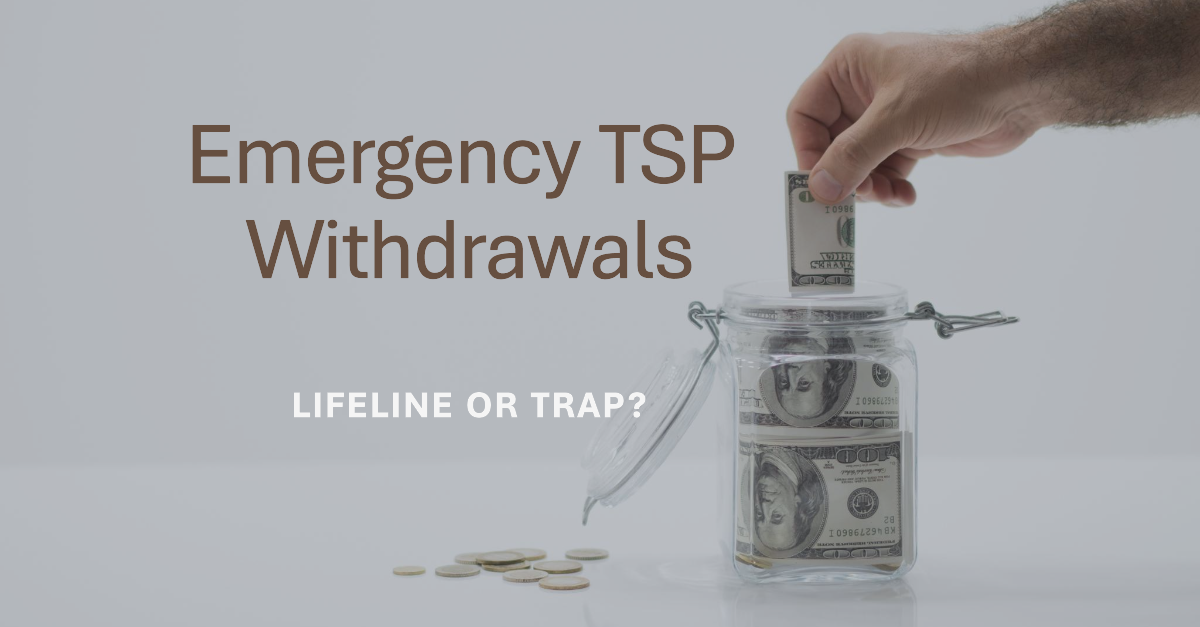TSP Hardship Withdrawals: A Lifeline or a Trap?
The Thrift Savings Plan (TSP) is a valuable retirement plan for federal employees and members of the uniformed services. It allows participants to set aside a portion of their income pre-tax, with the potential for agency-matching contributions. However, life can throw unexpected curveballs, leading some to consider hardship TSP withdrawals.
What are TSP Hardship Withdrawals?
A financial hardship withdrawal may allow for early distribution from your TSP account under specific circumstances. It is a TSP in-service withdrawal without meeting the normal age requirements. Before performing this kind of financial hardship in-service withdrawal, you must have a qualifying financial need.
Approved Hardship Withdrawal Reasons:
- Negative Cash Flow: You would need to show that your net income is consistently lower than your expenses and affirm that you have a negative monthly cash flow. Form TSP-76 can help you determine if you have negative cash flow. The best way is to log in to My Account on TSP.gov and use the online worksheet.
- Extraordinary Expenses: These are expenses not part of your regular monthly cash flow. However, only expenses you have not paid would count. You cannot claim TSP withdrawal hardship for expense reimbursements.
- Eligible Medical Expenses include medical expenses you have not paid for yourself or your dependents. Or household improvements for yourself, your spouse, or dependents.
- Personal Casualty Losses: Damage, destruction, or loss of property from events such as natural disaster, theft not caused by negligence, or willfully destroyed.
- Legal Expenses: Limited unpaid legal fees and court costs related to a separation or divorce
- FEMA Declarations: Your residence or workplace is located in an area designated by the Federal Emergency Management Agency
Knowledge is Confidence!
Tax Implications
Depending if you have balances in the Roth TSP, you can select the withdrawal from your Traditional, Roth, or pro-rata balance from the TSP. If you take it from the Roth TSP, only gains will be subject to federal income tax, state income tax, and early withdrawal penalty. If you take it from the Traditional TSP, the contributions and earnings will be subject to all three taxes.
Financial Implications & Changes to TSP Contribution Limitations
Unlike a TSP Loan, you cannot pay back the withdrawal. This will permanently decrease your TSP balance and miss potential growth. The TSP Modernization Act’s change is that you can resume contributions immediately. The agency will also continue matching contributions. You are no longer barred from contributing or missing matches for six months.
Pitfalls and Drawbacks
The long-term consequences of a hardship withdrawal can be significant. Your account balance will be reduced, and you’ll miss out on potential investment growth. Studies have shown that even small withdrawals early in your career can drastically impact your retirement savings due to lost compounding interest.
Beyond the financial implications, there can be psychological effects. Dipping into your retirement fund can trigger feelings of anxiety and regret. It can also be challenging to catch up on savings later, especially if your income hasn’t increased.
Alternatives to Consider: TSP Loan, Bank Loans, Roth IRAs
Before resorting to a hardship withdrawal, explore other options. If you have sufficient funds in your TSP, consider a TSP loan. This allows you to borrow against your own savings and repay it with interest, minimizing the impact on your retirement.
Other alternatives include tapping into emergency savings, borrowing from family or friends, or seeking a personal loan. If you have a Roth IRA, you can withdraw contributions at any time without taxes or penalty. You might also consider financial counseling to create a budget and develop a plan to overcome your financial difficulties.
Learn more about TSP Loans: Pros and Cons of Taking a TSP Loan
Roth IRA Withdrawal Rules: Roth TSP & Roth IRA 5-Year Rule on Withdrawals and Conversions
TSP hardship withdrawals can be a lifeline in times of financial distress, but they come with significant risks and drawbacks. It’s crucial to carefully weigh the potential consequences before making a decision. Consider alternative solutions and seek professional advice if needed. Remember, your future self will thank you for prioritizing your long-term financial well-being.
Frequently Asked Questions:
How long does TSP hardship withdrawal take?
Add your direct deposit information in MyAccounts at least seven days before the withdrawal request. If not, you must wait for a check to be mailed.
How often can you take a TSP hardship withdrawal?
There is a six-month waiting period between withdrawals. Keep in mind that this waiting period applies even if your request was reduced because you had insufficient funds.
How many hardship withdrawals are allowed in a year?
Because of the waiting period above, the most you can take is 2 per year.
What proof do you need for a hardship withdrawal?
The TSP will not ask for proof. However, it’s recommended that you keep relevant information for future reference. You will need to certify under penalty of perjury that a genuine financial hardship exists.
Can a TSP hardship withdrawal rejected?
There could be several reasons.
- TSP balance is below $1,000
- Already took a withdrawal within 6 months
- Withdrawal can’t be used for expenses already paid
Is there a TSP Hardship Withdrawal Form?
The best way to start a financial hardship in-service withdrawal request is to log in to My Accounts on TSP.gov or call ThriftLine at 877-968-3778.
Reach Out to Us!
If you have additional federal benefit questions, contact our team of CERTIFIED FINANCIAL PLANNER™ (CFP®), Chartered Federal Employee Benefits Consultants (ChFEBC℠), and Accredited Investment Fiduciaries (AIF®). At PlanWell, we are federal employee financial advisors with a focus on retirement planning. Learn more about our process designed for the career fed.
Preparing for federal retirement? Check out our scheduled federal retirement workshops. Sign up for our no-cost federal retirement webinars. Make sure to plan ahead and reserve your seat for our FERS webinar, held every three weeks. Want to have PlanWell host a federal retirement seminar for your agency? Reach out, and we’ll collaborate with HR to arrange an on-site FERS seminar.
Want to fast-track your federal retirement plan? Skip the FERS webinar and start a one-on-one conversation with a ChFEBC today. You can schedule a one-on-one meeting.










